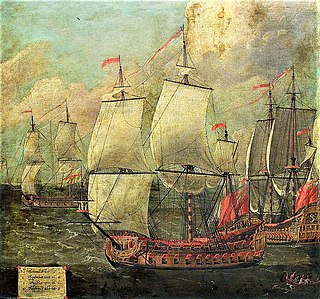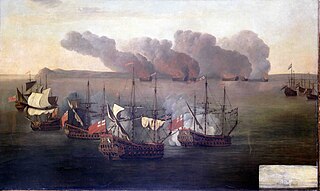Bristol was a 44-gun fourth rate vessel of the Commonwealth of England built under the 1651 Programme. She arrived too late for the First Anglo-Dutch War, however, was an active participant in the Second Anglo-Dutch War though in the Third she was no longer used as a line-of battle vessel and reverted to a role of cruising against privateers. She was lost in this role in the English Channel when she was captured by the French. Two weeks she was recaptured by the English and sank in 1709.
HMS Ruby was a 40-gun frigate of the Commonwealth of England, built by Peter Pett at Deptford. She took part in actions during all three of the Anglo-Dutch Wars of 1652–1654, 1665–1667 and 1672–1674. She later served in the West Indies, and in 1683 was sent to the Leeward Islands to protect British settlements against Caribbean pirate raids. In 1687, the English pirate Joseph Bannister was captured by the crew of Ruby and brought to Port Royal for trial. She was rebuilt in 1687. She was captured by the French in October 1707.

HMS Assurance was a 32-gun fourth-rate of the English Navy, built by Peter Pett I at Deptford Dockyard and launched in 1646. She was in the Parliamentary force during the English Civil War, then the Commonwealth Navy and was incorporated into the Royal Navy after the Restoration in 1660. During her time in the Commonwealth Navy she partook in the Battles of Dover, Portland, Gabbard and Texel. She foundered in a gale at Woolwich in 1660 and was salved. After the Restoration she partook in the Battle of Lowestoffe, the Four Days Fight and the Texel (1673). She was reduced to a Fifth Rate in 1690 before being sold in 1698.

HMS Adventure was a 34-gun fourth-rate of the English Navy, built by Peter Pett II at Woolwich Dockyard and launched in 1646. With the outbreak of the English Civil War she served on the Parliamentary side until 1649. She was incorporated into the Commonwealth Navy in 1650. She partook in the Battle off Dover in 1652, the Battle of Portland and the Battle of Gabbard in 1653. Adventure was employed on Bulstrode Whitelocke's embassy to Sweden, 1653–1654. After the Restoration she was incorporated into the Royal Navy. She was present at the Battle of Lowestoft (1665) and the Battle of Solebay (1672). She also participated in the Golden Horse and Two Lions actions in 1681. She was in the Battle of Barfleur in 1692. She captured several ships in the later part of her career, before being captured by the French in 1709.
HMS Dragon was a 38-gun fourth rate of the English Navy; she became part of the Royal Navy after the Restoration, built by the Master Shipwright Henry Goddard at Chatham and launched in 1647. She was the first frigate to be built at Chatham.

Elizabeth was a 32/38-gun fourth rate vessel of the Kingdom of England, one of four new frigates ordered and built under the 1647 Programme. Her initial commission was in the Parliamentary Naval Force during the English Civil War. During the First Anglo-Dutch War, she missed all the major Fleet actions as much of the time she was in the Mediterranean. During the Second Anglo-Dutch War, she participated in the St James Day Fight. She was burnt by the Dutch off Virginia in March 1667.
HMS President was a 34-gun fourth-rate of the English Navy, built by Peter Pett I at Deptford Dockyard and launched in 1650. She was incorporated into the Commonwealth Navy in 1650. She partook in the Battle off Dover and Kentish Knock in 1652, the Battle of Portland, the Gabbard and Scheveningen in 1653. She was renamed Bonaventure in 1660. After the Restoration she was incorporated into the Royal Navy. She was present at the Battle of Lowestoft (1665), the Four Days Battle and the Oxfordness in 1666. She was rebuilt in 1666. She was present at the Battle of Martinique in 1667, Battle of Solebay (1672), Battle of Schooneveld and Texel in 1673, the Battle of Beachy Head in 1690, the Battle of Barfleur 1692.
HMS Reserve was one of six 40-gun fourth-rate frigates, built for the Commonwealth of England under the 1650 Programme, after the Restoration of the monarchy in 1660 she was incorporated into the navy of the Kingdom of England. She partook in no major Fleet actions during the First Anglo-Dutch War. After the Restoration during the Second Anglo-Dutch War she partook in the Battle of Lowestoft, the Four Days' Battle and the St James Day Battle. She spent the bulk of her service either in the Mediterranean or at Newfoundland. She foundered off Yarmouth in November 1703.
The Pelican was one of six 40-gun fourth-rate frigates, built for the Commonwealth of England under the 1650 Programme. After commissioning she partook in the First Anglo-Dutch War being present at the Battles of Kentish Knock, Portland, the Gabbard and Scheveningen. She was accidentally burnt at Portsmouth in early 1656.

HMS Centurion was one of six 40-gun fourth-rate frigates, built for the Commonwealth of England under the 1650 Programme, she would be transferred to the navy of the Kingdom of England upon the Restoration of the monarchy in May 1660. When commissioned she partook in the First Anglo-Dutch War. After the first war ended she was in the Mediterranean fighting the Algerines at the Battle of Santa Cruz. She fought the battles of Dover, Portland, the Gabbard, and Scheveningen. During the Second Anglo-Dutch War she partook in the battles of Lowestoft and Orfordness. Following the second war she spent her time either in North America or the Mediterranean. She was wrecked in a storm in December 1689.

Foresight was a 40-gun fourth-rate of the Commonwealth of England, after the Restoration of the monarchy in 1660 she was incorporated into the Navy of the Kingdom of England. During her time in the Commonwealth Navy she partook in the First Anglo-Dutch War being present in the battles of Dungeness, Kentish Knock, Portland, The Gabbard and Scheveningen. She was also present at the Battle of Santa Cruz and the bombardment of Porto Farina, In the Second Anglo-Dutch War she was involved in the Battle of Vagen and the St James Day Fight. During the Third Anglo-Dutch War she participated in the battles of Schooneveld and Texel. For the remainder of her career she was in the West Indies, the Mediterranean and North American waters. She was wrecked south of Cuba in July 1698.
Laurel was a 48-gun fourth-rate of the navy of the Commonwealth of England. She participated in almost all major Fleet Actions of the First Anglo-Dutch War. She was an active participant in the battles of Kentish Knock, Dungeness, Portland, The Gabbard and Scheveningen. She went to the west Indies with Admiral William Penn. She was wrecked in May 1657.
HMS Portsmouth was a 34-gun fourth-rate of the English Navy, built by Thomas Eastwood at Portsmouth Dockyard and launched in 1649. She was incorporated into the Commonwealth Navy in 1650. She partook in the Battle off Dover and Kentish Knock in 1652, the Gabbard and Scheveningen in 1653. After the Restoration she was incorporated into the Royal Navy. She was present at the Battle of Lowestoft (1665) and the Four Days Battle. She was present at the Texel in 1673, the Battle of Bantry Bay in 1689. She was captured by the French in August 1689 and blown up.
The Expedition was a 30-gun "pinnace" in the service of the English Navy Royal. After an initial participation in a punitive attack on Morocco, she spent the majority of her career in Home Waters. During the English Civil War she was employed in the Parliamentary Naval Force. In 1551 she was assigned to the Commonwealth Navy. During the First Dutch War she took part in the Battle of Portland, the Battle of the Gabbard and the Battle of Scheveningen in 1553. During the Second Dutch War she participated in the Battle of Lowestoft in 1665 and the Four Days' Battle and the St James' Day Battle (Orfordness) in 1666. She was re-classed as a 32-gun ship in 1666, but then again re-rated and converted to a fireship in June 1667, and then sold in October 1667.
Providence was a 30-gun "pinnace" in the service of the English Navy Royal. After an initial participation in a punitive attack on Morocco, she spent the majority of her career in Home Waters. During the English Civil War she was employed in the Parliamentary Naval Force. In 1551 she was assigned to the Commonwealth Navy. During the First Dutch War she took part in the Battle of Portland, the Battle of the Gabbard and the Battle of Scheveningen in 1553. During the Second Dutch War she participated in the Battle of Lowestoft in 1665 and the Four Days' Battle and the St James' Day Battle (Orfordness) in 1666. She was re-classed as a 32-gun ship in 1666, but then again re-rated and converted to a fireship in June 1667, but was wrecked at Tangier on 31 October 1667.
Guinea was a 38-gun fourth rate vessel of the Kingdom of England, Her initial commission was as a Royalist vessel during the English Civil War named Charles. She was captured then commissioned into the Parliamentary Naval Force as Guinea. During the First Anglo-Dutch War she partook in the Battle of Kentish Knock, the Battle of Portland and the Battle of The Gabbard. During the Second Anglo-Dutch War she participated in the Battle of Lowestoft, the Battle of Vagen and the St James Day Fight. She was sold on 27 November 1667.
Marmaduke was a 40-gun fourth rate vessel of the Kingdom of England, Her initial commission was as a Royalist vessel during the English Civil War named Revenge. She defected to the Parliamentarians then commissioned as Marmaduke. During the First Anglo-Dutch War she partook in the Battle of The Gabbard. During the Second Anglo-Dutch War she participated in the Four Days' Fight. She was scuttled during the Dutch raid on the Medway and sold in 1669.
Amity was a 36-gun fourth rate vessel, formerly belonging to the Commonwealth of England. She was hired by Parliament in November 1649, and later purchased on 18 January 1650, thus renamed. She was commissioned into the Parliamentary Naval Force as Amity. During the First Anglo-Dutch War she partook in the Battle of Portland and the Battle of The Gabbard. Later, after the Restoration in May 1660, she was incorporated into the English Navy. During the Second Anglo-Dutch War she participated in the Battle of Lowestoft, the Four Days' Battle and the St James Day Fight. She was sold on 27 November 1667.
Convertine was a 36-gun fourth rate vessel captured from the Portuguese by the Commonwealth of England. She was commissioned into the Parliamentary Naval Force as Convertine. During the First Anglo-Dutch War she partook in the Battle of Dungeness, Battle of Portland and the Battle of the Gabbard. During the Second Anglo-Dutch War she participated in the Battle of Lowestoft and the Four Days' Battle. She was captured during the Four Days' Battle.
The English ship Martin was a 14-gun sixth rate vessel built under the 1651 Programme at Portsmouth Dockyard for the Commonwealth of England in 1651/52. Her service in the Commonwealth Navy was very active. She participated in the Battles of Dover, Portland and the Gabbard. She was with Robert Blake at Porto Farina. She was the main vessel at the Capture of Jamaica in 1655. With the Restoration she became HMS Martin. During the Second Anglo-Dutch War she was in the initial battle of Lowestoft then the Battle of Vagen. She was sold in February 1667.


